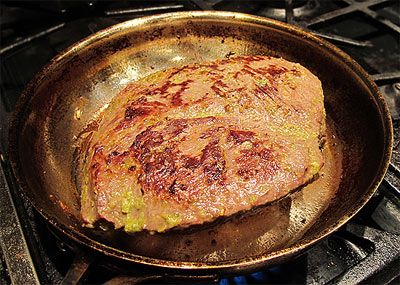
Our personal decision to drool warps our sensory experience of the steak. However, what we are actually sensing is our own saliva, which the brain induced our salivary glands to release. Cover with foil, reduce heat to 325 degrees and cook approximately 1-1/2 to 2 hours (depending on the size of your roast), OR until fork goes easily into meat.

(Just look at the photo above.) As a result, when we eat the more appetizing (yet less juicy) steak, the meat seems to be juicier. Put rump roast into large roasting pan and sear each side of roast for about 15 minutes until dark brown. Use a sharp knife to achieve accurate cuts. Sear Answer: To sear, place the steak directly on the stovetop over medium-high heat and cook for 23 minutes per side. Do not move the steak until it turns golden brown. Once the pan is hot, carefully add the steak to the pan. Remove however much fat you want from the meat. To sear, place the steak on a preheated skillet over medium-high heat. Preheat the oven to 200 degrees F (95 degrees C). Let your beef roast sit on the counter for at least 20 minutes to get closer to room temperature. The disquieting explanation of this culinary illusion is that a well-seared steak - its Maillard crust crisp and crackling, its interior plush and bloody – makes us drool in anticipation. Remove roast from the refrigerator and allow to come to room temperature, about 2 hours. While a well-seared steak is literally drier - the sizzle in the pan is the sound of all those interior juices boiling away - it still tastes juicier. But in almost all cases, it's better to sear the food after it's roasted, not at the start.īut the paradox remains: If searing a piece of meat leads to less umami juiciness, then why do we believe otherwise? It turns out that our intuitions about searing protein aren't totally wrong.
Searing a roast series#
On the other hand, searing does improve flavor by catalyzing the Maillard browning reactions, a series of chemical reactions that rapidly take place when proteins and sugars are heated to around 300☏ or so, improving the flavor and texture of the dish.
Searing a roast how to#
It's been conclusively proven false many times, including in our own post on How to Cook a Perfect Prime Rib, where we found that when roasting a standing roast, it in fact lost 1.68% more juice if it was seared before roasting rather than after! The same is true for pork roasts, steaks, hamburgers, chicken cutlets, you name it.

Bake for 45 minutes to an hour, or until the internal temperature of the meat reaches 125☏/50☌ for.

Remove from the oven and place a wire rack on top of a baking sheet. Using a paper towel, pat the steak dry and thoroughly season both sides of the steak with salt and pepper. This is the oldest one in the book, and still gets repeated-by many highly respected cookbook authors and chefs!-to this day. Preheat the oven to 200 degrees Fahrenheit/95 degrees Celsius.


 0 kommentar(er)
0 kommentar(er)
